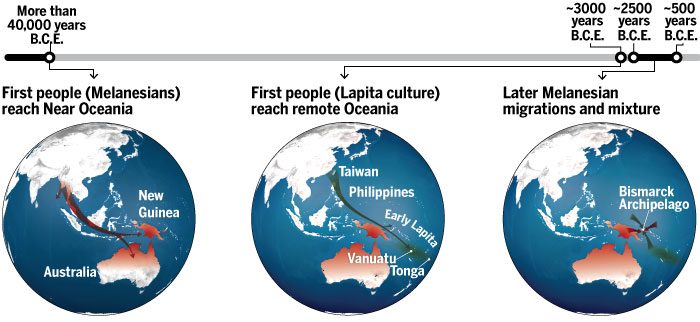“All the evidence from different disciplines has come together … the genomics has clinched it.” – Peter Bellwood, archaeologist, Australian National University in Canberra

PHOTO: hokulea.com
Two theories about the origins of the first Polynesian settlers have been battling it out in the historical community. Some researchers believe that the first Polynesians sailed straight from East Asia to the Pacific Islands without stopping to mix with the local Melanesian hunter-gather societies already present.
For years, however, the prevailing theory of how the first Polynesian settlers colonized the hundreds of thousands of islands dotting the Pacific Ocean has been the so-called “slow-boat” theory. This theory states that the Polynesians slowly migrated to the Pacific Islands from East Asia by stopping at each already-inhabited island they came to, taking enough time to mix with the local Melanesians before moving on.
Now, the first genome-wide study of ancient DNA taking from four prehistoric Polynesian women has seemed to give the first idea a little bit more clout.
It’s a “game-changing” paper according to Oxford University. The experts there believe that the paper settles the age-old dispute between the two theories.
Recently, an international team of researchers analyzed DNA from the skeletons of four women from the islands of Vanuatu and Tonga. Three are directly associated with the Lapita – the original prehistoric Polynesian ancestors.
Well, the DNA doesn’t lie. The researchers discovered that the four women belonged to a population that was, at their basic molecular level, completely different to people living in surrounding Melanesian islands. Their DNA closely resembled not the neighboring populations of Papua New Guinea, but ancient peoples from Taiwan and the Philippines.
According to the DNA, then, these women were descended from people in East Asia who swept across the Pacific Ocean, island-hopping and refusing to mix with the Melanesian inhabitants.
“The Lapita have no evidence for Papuan ancestry,” says Pontus Skoglund, a postdoc in David Reich’s lab at Harvad Medical School in Boston.
This isn’t to say that the Polynesians never mixed with the Melanesians. Many modern-day Polynesians carry Melanesian DNA, but the DNA sequences remain intact, suggesting that it was introduced much later, after the Polynesian settlers had time to establish their culture in the Pacific. The mingling of populations probably occurred around 2,000 years ago, much later than other theories would have it.

PHOTO: sciencemag.org
This new study matches other evidence that researchers from different disciplines have also discovered. Linguistic evidence shows that Polynesian dialects match dialects from East Asian and Oceania, and are completely distinct creatures separate from Papuan languages in Melanesia.
It also matches the pattern seen around the world in ancient cultures where there is conflict and culture-clashing between hunter-gather societies, like the Melanesians, and farming communities like the Polynesians from East Asia.
“Farmers move in and don’t mix much with the hunter-gatherers,” evolutionary geneticist Mark Thomas of University College London pointed out, “We see this again and again and again.”
So, the evidence concludes: the first, prehistoric Polynesian settlers did not take their time crossing the Pacific Ocean. Instead, they were a group of Asian farmers who wanted to seek out new, fertile land, and were focused about doing so. They didn’t look for islands that were already inhabited, settle down in them for a while, and then move on. Instead, they beelined for the Pacific Islands and made their home there, developing a distinct and unique culture and language dialect separate from their neighbors. They would create stamped red pottery, obsidian tools, shell ornaments, and grow taro, yams, and breadfruit.
More than likely, a thousand years later the Melanesians would eventually trickle down into the now-settled Polynesian islands and begin mixing and integrating with these farming communities, which is how the Melenesian DNA would eventual be introduced into these people groups.
Finally, the decades-long debate is settled.

